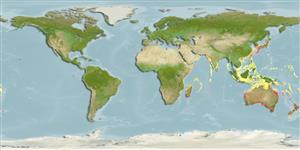Euptilota articulata (J. Agardh) F. Schmitz
| Native range | All suitable habitat | Point map | Year 2050 |

|
| This map was computer-generated and has not yet been reviewed. |
| Euptilota articulata AquaMaps Data sources: GBIF OBIS |
Upload your photos
Google image |
No photo available for this species.No drawings available for Ceramiaceae.
Google image |
No photo available for this species.
Classification / Names Common names | Synonyms | CoL | ITIS | WoRMS
Florideophyceae | Ceramiales | Ceramiaceae
Environment: milieu / climate zone / depth range / distribution range Ecology
Sessile. Tropical
Distribution Countries | FAO areas | Ecosystems | Occurrences | Introductions
Indian Ocean: In India and Kwazulu-Natal, South Africa, east to Australia (Western Australia, Southern Australia and Victoria); Pacific Ocean: In Japan, Papua New Guinea south to Tasmania, including Lord Howe Island, east to Fiji.
Length at first maturity / Size / Weight / Age
Maturity: Lm ? range ? - ? cm Max length : 25.0 cm TL male/unsexed; (Ref. 82093)
Short description Morphology
Thalli are erect, to 25 cm high and pinnately branched up to 5 orders. A percurrent main axis is lacking.The holdfast is densely rhizoidal. Axes are corticated from close to the apices, with corticating filaments arising from the periaxial cells 5 to 10 cells proximal to the apex. Near the base the axes attain a width of 1.5 mm. Each axial cell bears a single lateral in a distichous-alternate pattern. Determinate branchlets are ecorticate, straight, 12-17 cells long and pinnately branched. Spinelike cells are absent. Indeterminate branchlets are formed irregularly and repeat the branching pattern of the main axes. Tetrahedrally divided tetrasporangia (40-52 μm in diameter) are borne laterally or terminally on the ultimate branchlets. Gametophytic plants were not observed (Ref. 82093).
Euptilota articulata has only been collected once in situ, at a depth of 35 m in southern Natal. The specimen in the Norris Herbarium (UN) was collected from the drift (Ref. 82093).
Life cycle and mating behavior Maturity | Reproduction | Spawning | Eggs | Fecundity | Larvae
Main reference
References | Coordinator | Collaborators
Guiry, M.D. and G.M. Guiry. 2009. (Ref. 80701)
IUCN Red List Status (Ref. 130435)
CITES status (Ref. 108899)
Not Evaluated
CMS (Ref. 116361)
Not Evaluated
Threat to humans
Human uses
| FishSource |
Tools
More information
Internet sources
BHL | BOLD Systems | CISTI | DiscoverLife | FAO(Publication : search) | Fishipedia | GenBank (genome, nucleotide) | GloBI | Gomexsi | Google Books | Google Scholar | Google | PubMed | AlgaeBase | Tree of Life | Wikipedia (Go, Search) | Zoological Record
Estimates based on models
Preferred temperature
(Ref. 115969): 18.1 - 24.9, mean 21.5 (based on 62 cells).


